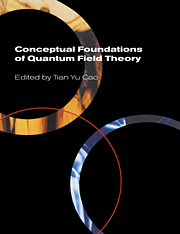Book contents
- Frontmatter
- Contents
- List of contributors
- Preface
- Photographs of the conference
- Introduction: Conceptual issues in quantum field theory
- Part One Philosophers' interest in quantum field theory
- Part Two Three approaches to the foundations of quantum field theory
- Part Three
- 7 Does quantum field theory need a foundation?
- Part Four Mathematics, statistics and quantum field theory
- Part Five Quantum field theory and space-time
- Part Six
- Part Seven Renormalization group
- Part Eight Non-Abelian gauge theory
- Part Nine The ontology of particles or fields
- Part Ten
- Name index
- Subject index
7 - Does quantum field theory need a foundation?
Published online by Cambridge University Press: 22 September 2009
- Frontmatter
- Contents
- List of contributors
- Preface
- Photographs of the conference
- Introduction: Conceptual issues in quantum field theory
- Part One Philosophers' interest in quantum field theory
- Part Two Three approaches to the foundations of quantum field theory
- Part Three
- 7 Does quantum field theory need a foundation?
- Part Four Mathematics, statistics and quantum field theory
- Part Five Quantum field theory and space-time
- Part Six
- Part Seven Renormalization group
- Part Eight Non-Abelian gauge theory
- Part Nine The ontology of particles or fields
- Part Ten
- Name index
- Subject index
Summary
Once upon a time, there was a controversy in particle physics. [Some physicists] searched for a self-consistent interpretation wherein all [particles] were equally elementary. Others... insisted on the existence of a small number of fundamental constituents and a simple underlying force law... Many recent experimental and theoretical developments seem to confirm the latter philosophy and lead toward a unique, unified, and remarkably simple and successful view of particle physics.
Introduction
A consistent description of all observed phenomena of the microworld is at hand! The so-called standard model of elementary particle physics grew by fits and starts from an exceedingly complex interplay between experiment and theory. In recent decades, experimentalists, with immense fortitude and generous funding, have identified and studied what appear to be the basic building blocks of matter and the fundamental forces that govern their interactions. Meanwhile, theorists have laboriously created, refined and reformulated a mathematical framework - quantum field theory - in terms of which the standard model is expressed. Aside from the occasional appearance (and disappearance) of conflicting data, the standard model has met every experimental test. And yet, too many deep questions remain unanswered for the standard model, and hence quantum field theory, to be the last word. Many theoretical physicists believe that an entirely new framework is needed - superstring theory or something like it - that will once again revise our understanding of space, time and matter.
In the course of these developments, the conceptual basis of the present theory has been obscured.
- Type
- Chapter
- Information
- Conceptual Foundations of Quantum Field Theory , pp. 74 - 88Publisher: Cambridge University PressPrint publication year: 1999
- 4
- Cited by



